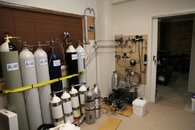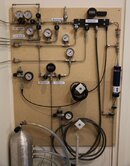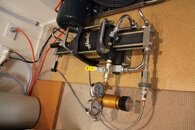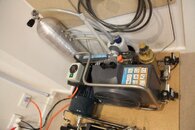Hi Ian,
All input and feedback/advice is welcome.
The drawing is in AutoCAD and is not to scale. It has been a work in progress and probably took about 20 hours I suppose. I have a few versions as the panel has grown and it is now called Frankenpanel as it keeps morphing.
LP Banks are rated to 200 Bar working pressure, I normally pump them to 220 and they cool back a bit to around 210/205 depending on how empty they are.
The HP bank is rated to 350 Bar but I cut it off at 330 and don't let it drop below 250 Bar.
All the tubing is 316 SS 1/4 inch x .9mm rated to 5000 PSI working pressure.
All banks are 50 litre.
I never leave the Haskel running by itself and turn the regulator down to zero and turn the drive bank off at the valve when not in use. The OPV is there to stop the booster running over 175psi if I turn something the wrong way by mistake.
I don't have a big enough LP compressor to keep up with this hungry Haskel and the single bank keeps up fairly well. I do however have two 3000PSI Swagelok plug valves between the booster, so I can supplement the drive gas with the two LP banks if need be. If I do this, I always turn the drive gas bank off and just run the other two through the cross and into the booster. Please clarify what you mean by the booster won't run long if being driven by the AE regulator? Are they dirty, are they troublesome...??
Yes, the DIN on the output is there so I can boost back through the panel by connecting the short whip in there. The Tee off the Oxygen main line and the cross off the Helium main line is so I can boost straight from the banks of Oxygen and Helium without changing any fittings and the digital gauge is there so I know exactly what is left in my banks after boosting those gasses. It works well. The analogue gauges are really panel bling and there so I don't have to turn my head and look at the bank regulators, which are just welding reg sets.
The Undersea filter is so small because it is about the same capacity as the P21 on the Oceanus that is supplying it and is my first attempt at better filtration. Most likely I'll put a 33-inch tower on there in place of the Undersea one and take the dessicant and activated carbon out of the P21 repackable filter, so it just acts as a separator. I have fitted solenoid controlled timed auto dumps to the 2nd stage separator and the final separator/filter (P21) and I have them set to dump every 10 minutes. The bypass is so I can save filter life when filling only the Booster drive gas bank, but I will probably do away with that part and the drive gas bank in favour of two more LP air quality banks and filter everything with the 33-inch tower.
Yes, the valves on the banks are Swagelok 3000 PSI plug valves with harder 90 duro o-rings and they seem to be okay to date if I move them slowly and not under full pressure. I have had to rebuild them a couple of times when they had softer o-rings - mainly the small o-ring, which is a Parker 902 odd size, a little smaller than an 010.
All the valves that are running HP are Sherwood 6000 PSI models.
Oxygen are Hoke 5000 PSI needle valves, apart from the one feeding the booster, which is a Sherwood as it has a much higher Cv = Flow Coefficient.
On the nitrox stick, yes the intake is close, but there are about 3 practice golf balls as baffles between the filter and the intake. I only pay $28 for a 50 litre cylinder of oxygen, so I'm not overly concerned about losing a few litres here and there at .0028 cents a litre

But you are right, it could be improved with a length of tube. Since I got the booster, I tend not to bother with the nitrox/trimix sticks anyway. The drawing shows the intake of the compressor permanently connected to the sticks, but they are not normally permanently connected, I just plug them in if I want to use them.
I will also add a second Oxygen bank in there too in the not too distant future.
Thanks for your nice comments and advice, I know that you know your stuff.
Kind regards,
Jason








